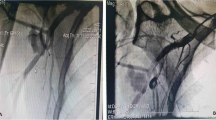Abstract
Trauma to the axillary vessel is uncommon, and most of the time, it is associated with injury to other accompanying structures including nerves and bones. An isolated injury to the axillary vein is of very rare occurrence, and it is hardly reported in the literature. There is a high risk of morbidity and mortality associated with venous injury in comparison to arterial injury. Ligation is one of the options in the case of a difficult venous injury. Reconstruction, however challenging for venous injuries, is generally preferable if possible. We discuss a case of a 14-year-old boy who arrived in the emergency department with severe bleeding from the axilla. Most of the time, gunshot, sharp, penetrating, or warfare injuries are associated with axillary vessel injuries. But in this case, the mode of injury was very trivial and sustained as a result of some debris being blasted off in a nearby fire during the winter season. Because the bleeding was so severe, the patient was rushed to the operating room, and the wound was explored. Indigenous-made slings of glove rings were employed for proximal and distal control of the axillary vein, and the rent in the axillary vein was repaired with a successful postoperative outcome. Early recognition and intervention in cases of vascular trauma are paramount to saving the patient’s limb and life. An axillary vein injury can be repaired successfully using minimal resources with a good surgical outcome.




Similar content being viewed by others
Data Availability
All data pertaining to this article are included within the manuscript as written.
Code Availability
Not applicable.
References
Demetriades D, Asensio. JA. Subclavian and axillary vascular injuries. Surg Clin North Am. 2001;81:1357–73, xiii.
Fitridge RA, Raptis S, Miller JH, Faris I. Upper ekstremity arterial injuries. Experience at the Royal Adelaide Hospital 1969 to 1991. J Vasc Surg. 1994;20(6):941–6.
Aksoy M, Tunca T, Yanar H, et al. Traumatic injuries to the subclavian and axillary arteries: a 13-year review. Surg Today. 2005;35:561–5.
Graham JM, Mattox KL, Feliciano DV, DeBakey ME. Vascular injuries of the axilla. Ann Surg. 1982;195(2):232–8.
Shaikh S, Boneva D, Hai S, McKenney M, Elkbuli A. Ballistic axillary vein transection: a case report. Am J Case Rep. 2019;14(20):1869–73.
Iscan S, Etli M, Gursu O, et al. Isolated subclavian vein injury: a rare and high mortality case. Case Rep Vasc Med. 2013;2013: 152762.
McCready RA, Procter CD, Hyde GL. Subclavian-axillary vascular trauma. J Vasc Surg. 1986;3(1):24–31.
Timberlake GA, Kerstein MD. Venous injury: to repair or ligate, the dilemma revisited. Am Surg. 1995;61(2):139–45.
Feliciano DV, Moore EE, West MA, et al. Western trauma association critical decisions in trauma: evaluation and management of peripheral vascular injury, Part II. J Trauma Acute Care Surg. 2013;75:391–7.
Author information
Authors and Affiliations
Contributions
Concept, design, material, data, literature search and review, manuscript preparation, and final approval by KT, SVG, and JK; material, literature search and review, critical review of a manuscript, and final approval by PK. The manuscript is original work and has been read and approved by all the authors. Requirements for authorship have been met.
Corresponding author
Ethics declarations
Ethics Approval
Not applicable.
Consent to Participate
Not applicable.
Consent for Publication
Obtained written consent from the subject’s parents.
Conflict of Interest
The authors declare no competing interests.
Additional information
Publisher's Note
Springer Nature remains neutral with regard to jurisdictional claims in published maps and institutional affiliations.
This article is part of the Topical Collection on Surgery.
Rights and permissions
Springer Nature or its licensor (e.g. a society or other partner) holds exclusive rights to this article under a publishing agreement with the author(s) or other rightsholder(s); author self-archiving of the accepted manuscript version of this article is solely governed by the terms of such publishing agreement and applicable law.
About this article
Cite this article
Tiwari, K., Gupta, S.V., Kumar, J. et al. An Unusual Case of Isolated Axillary Vein Injury Managed Successfully Using Indigenous Resources: Case Report. SN Compr. Clin. Med. 5, 206 (2023). https://doi.org/10.1007/s42399-023-01550-9
Accepted:
Published:
DOI: https://doi.org/10.1007/s42399-023-01550-9




